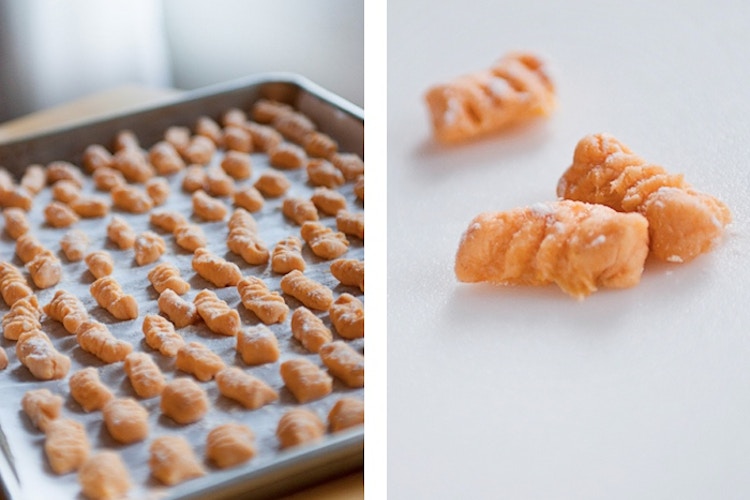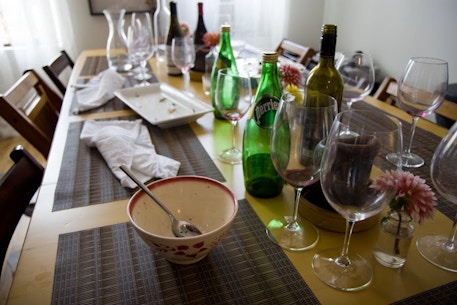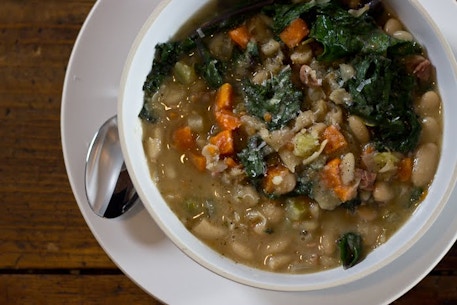How to Make Butternut Squash Gnocchi
Photos by Signe Birck
This time of year–when the weather is cooling off and the leaves are starting to change–I start craving butternut squash. To me, this long, funky-shaped squash, with its bright orange, slightly sweet flesh, represents fall. I love it in all its forms–roasted, sautéed, mashed, puréed. But my favorite way to enjoy butternut squash is in gnocchi–those delicate little larvae-shaped dumplings that taste so good, yet are so painstaking to make.
As I was planning the menu for my dinner party last weekend, I knew I wanted to make butternut squash gnocchi for the first course. I pictured plates of tiny, beautifully-shaped dumplings, tossed with browned sage butter and sprinkled with grated Parmesan. I imagined the oohs and ahhs that would involuntarily escape the mouths of my guests. But I hesitated, reminding myself that making gnocchi from scratch would involve a pretty serious time commitment, and that there was plenty of room for error with the dough. What if I went through all that effort and they turned out as ugly little leaden lumps? I told myself that it would be crazy to try and make enough gnocchi for 10 people in addition to everything else I was planning to make. But then I thought how delicious they would be, and how this was the perfect chance to practice my rather rusty gnocchi-making skills (let's just say it had been a few years...)

I researched a bunch of gnocchi recipes online, and decided that if anyone knew how to make gnocchi, it would be Lidia Bastianich. Using her recipe as a guide (of course I made a few changes along the way...), I started with the butternut squash purée: I roasted the butternut squash, whizzed it in a food processor, then cooked it for five minutes over the stove top to remove all additional moisture. Like traditional gnocchi, Lidia's recipe calls for potatoes as well. I peeled and boiled a few spuds and pressed them through a ricer while they were still warm. I know a potato ricer may not be a tool you have lying around, but it's worth investing in one if you like to make mashed potatoes or gnocchi. It will give your potatoes the light, silky texture needed to make a smooth dough (or a super-creamy potato purée). Let the butternut squash puree and potatoes cool before proceeding to the next step.
In a bowl (see picture above), I gently combined the butternut squash puree, the riced potatoes, an egg, salt, grated Parmesan, and about a cup of flour with a spatula. I gradually added another half cup of flour to create a soft, slightly sticky dough. (The recipe called for 1 3/4 cups of flour, but I only ended up using 1 1/2 cups.) The key here is not to overwork the dough! The less flour you use, the better–you want your dough to be smooth and elastic like Play-Doh, not dry and brittle. At this point, you can remove the dough to a floured surface and knead a few times until you have a smooth ball of dough. Just sprinkle with additional flour if it's still sticky. Divide the dough in half with a bread cutter (this is a really useful, inexpensive tool that will also come in handy when making bread or pastry), then into fourths and eighths. You should have eight small balls of dough.

Now for the fun part...rolling and shaping the gnocchi!! Go ahead and line two sheet trays with parchment paper–you will need these to put the gnocchi on as you shape them. Brandon made a little step-by-step video (below) of me shaping one of the small dough balls into a long rope, cutting it into little pillows, then rolling each dumpling over fork tines to create the traditional gnocchi ridges. Check it out–it's sort of like a gnocchi-making music video (and therefore way more fun to watch than to read boring step-by-step instructions...). This is our first how-to video, with more on the way...let us know what you think!
A big lesson I learned while making gnocchi is that you have to be careful not to let the dough get too warm, or it will get too soft to hold its shape properly. I found that it was really helpful to chill the gnocchi in the refrigerator for about half an hour between cutting them into little pillows and shaping them into gnocchi. I chilled them again before I boiled them–you don't want the dough to be too soft or it will fall apart in the boiling water. Also, if you want to make the gnocchi in advance, you can freeze them for several days or even weeks. Just take them directly from the freezer and place them in the boiling water. They are ready when they float to the surface, usually about 3 or 4 minutes.
 GUEST PHOTO BY SIGNE BIRCKIn the end, the gnocchi were delicious. I did everything in advance–even the boiling can be done ahead–so all I had to do was sauté them in the sage butter right before serving. To be honest, from start to finish, they took me about six hours to make. Probably because I was slow and sort of learning as I went, but I definitely loved the way they turned out and I can't wait to make them again!
GUEST PHOTO BY SIGNE BIRCKIn the end, the gnocchi were delicious. I did everything in advance–even the boiling can be done ahead–so all I had to do was sauté them in the sage butter right before serving. To be honest, from start to finish, they took me about six hours to make. Probably because I was slow and sort of learning as I went, but I definitely loved the way they turned out and I can't wait to make them again!BUTTERNUT SQUASH GNOCCHI WITH SAGE BUTTER Makes 6 main course servings, or 10 appetizer portions
1 2-pound butternut squash
Olive oil for brushing
Two 12-ounce russet potatoes, peeled and quartered
3/4 cup finely grated Parmesan cheese, divided
1 large egg, beaten
Pinch of freshly grated nutmeg
1 teaspoon salt
1 1/2 cups (or more) all purpose flour
1/2 cup (1 stick) butter
2 tablespoons chopped fresh sage
Salt and freshly ground pepper
Additional grated Parmesan cheese
Fried sage leaves
Preheat the oven to 425 degrees F. Cut the butternut squash in half, scoop out the seeds and pulp, and brush with olive oil. Roast, cut-side up, for about an hour, or until tender when pierced with a knife and beginning to brown. When cool enough to handle, scoop the flesh into a food processor and purée until smooth. Place the puree in a small saucepan and cook over medium heat, stirring constantly, until the puré is thickened, about five minutes. (This will remove all extra moisture from the squash.) Set aside one cup of purée for the gnocchi and save the rest for another use.
Meanwhile, boil the potatoes in salted water for about 20 minutes, or until tender when pierced with a knife. Drain the potatoes and press them through a potato ricer into a medium bowl. Measure out two cups of potatoes for the gnocchi. Let cool completely. Measure out the remaining gnocchi ingredients and have lined up ready to go. Prepare two parchment-lined sheet trays.
Using a spatula, gently combine the squash purée, potatoes, 1/2 cup Parmesan, egg, pinch of nutmeg, and salt in a large bowl. Fold in a cup of flour, gradually adding the remaining half cup until a soft, slightly sticky dough forms. Feel free to add a few more tablespoons of flour if necessary, taking care not to overwork the dough.
Turn the dough onto a floured surface and knead several times to form a smooth ball. Using a floured dough cutter (or a sharp floured knife), divide the dough in half. Then cut into fourths, and eighths, sprinkling the dough balls with additional flour.
Working with one dough ball at a time, pat the ball into a small log and begin rolling it into a long rope. The dough should ideally feel sort of like Play-Doh, though mine felt slightly softer. If it becomes too soft to roll, use your hands to stretch the dough and pat it into a long rope about 1/2- to 3/4-inch thick (depending on how big you want your gnocchi to be). Using the dough cutter, cut the rope into 1/2- to 3/4-inch pieces (again, personal preference). Place the little dumplings on the parchment-lined sheet tray and chill for about 30 minutes in the refrigerator. This step wasn't in the original recipe, but I found it extremely helpful in shaping the dough–if it's too soft, it's very difficult to shape the gnocchi.
Remove the dumplings from the fridge and roll them, one by one, over the back of fork tines dipped in flour. Press lightly with your thumb as you roll, and they should have small grooves down one side. Watch the video for clarification! Place the dumplings back on the sheet tray and let chill until ready to boil. Continue the process with the remaining dough balls.
Working in batches, boil the gnocchi in a large pot of salted water until they rise to the surface. Remove them with a slotted spoon onto two parchment-lined sheet trays. I did this in four batches, and each batch took around 3-5 minutes. Let chill until just before dinner.
To make the sage butter, heat two large sauté pans over medium-high heat. Place 1/2 stick of butter in each pan and let melt and begin to brown just slightly, about 2 to 3 minutes. Add the sage and cook for an additional minute. Add half the gnocchi to each pan and sauté until heated through and just beginning to brown, about 5 minutes. Season with salt and pepper and toss with the additional 1/4 cup Parmesan.
Serve the gnocchi with additional grated Parmesan and topped with a fried sage leaf. Buon appetito!



